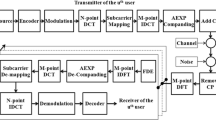Abstract
The conventional frequency domain square-root raised cosine (Nyquist) chip waveform has much poorer anti-multiple-access-interference (anti-MAI) capability than the optimal band- limited waveform in direct sequence code division multiple access (DS-CDMA) systems. However, the digital implementation of the optimal chip pulse is very costly due to the slow decaying rate of the time waveform. In addition, its eye diagram and envelope uniformity are worse than the Nyquist pulse for a wide range of roll-off factor, which will incur performance degradation due to timing jitters and post non-linear processing. In this paper, based on an elementary density function of a second-order polynomial, a class of second-order continuity pulses is proposed. From this class of pulses, we can find some members having faster decaying rate, bigger eye opening, more uniform envelope and stronger anti-MAI capability than the Nyquist waveform. The normalized-band-width-pulse-shape-factor product, the decaying rate of the tail of the time waveform, the opening of the eye diagram, and the envelope uniformity of the second-order continuity pulses are addressed in the paper that provide the basic information for the selection of the chip pulse for CDMA systems.
Similar content being viewed by others
References
Anjaria, R., & Wyrwas, R. (1992). The effect of chip waveform on the performance of CDMA systems in multipath, fading, noisy channels. In Proceedings of the 42nd VTS conference, Denver, pp. 672–675.
Asano, Y., Daido, Y., & Holtzman, J. M. (1993). evaluation for band-limited DS-CDMA communication system. In Proceedings of the IEEE vehicular technology conference, Secaucus, NJ, pp. 464–468.
Beaulieu N.C., Tan C.C., Damen M.O. (2001). A “better than” Nyquist pulse. IEEE Communication Letters 5, 367–368
Chaib J.P., Leib H. (1996). Chip shaping and channel coding for CDMA. European Transactions on Telecommunications 7, 133–143
Cho J.H., Lehnert J.S. (2002). An optimal signal design for band-limited asynchronous DS-CDMA communications. IEEE Transactions Information Theory 48, 1172–1185
Cho, J. H., & Lehnert, J. S. (2001). System design for DS/SSMA communications with negative chip excess bandwidth. In Proceedings of the IEEE military communication conference, Vol. 2, McLean, VA, pp. 1050–1054.
Cho J.H., Jeong Y.K., Lehnert J.S. (2002). Average bit-error-rate performance of band-limited DS/SSMA communications. IEEE Transactions on Communications 50, 1150–1159
Dallas P.I., Pavlidou F.N. (1996). Innovative chip waveforms in microcellular DS/CDMA packet mobile radio. IEEE Transactions on Communications 44, 1413–1416
Gao W., Cho J.H., Lehnert J.S. (2002). Chip waveform design for DS/SSMA systems with aperiodic random spreading sequences. IEEE Transactions on Wireless Communications 1, 37–45
Landolsi M.A., Stark W.E. (1999). DS-CDMA chip waveform design for minimal interference under bandwidth, phase, and envelope constraints. IEEE Transactions on Communications 47, 1737–1746
Luo T., Pasupathy S., Sousa E.S. (2002). Interference control and chip waveform design in multirate DS-CDMA communications systems. IEEE Transactions on Wireless Communications 1, 56–66
Nguyen, H. H. (2002). A study of band-limited chip waveforms for asynchronous DS-CDMA systems. In Proceedings of the IEEE Canadian conference on electrical and computer engineering, pp. 1271–1275.
Nguyen H.H., Shwedyk E. (2001). On error probability of DS-CDMA systems with arbitrary chip waveforms. IEEE Communication Letters 5, 78–80
Nyquist H. (1928). Certain topics in telegraph transmission theory. Transactions of the AIEE 47, 617–644
Ojanpera T., Prasad R. (1998). An overview of air multiple access for IMT-2000/UMTS. IEEE Communications Magazine 36, 82–95
Park S., Park S.C., Lee K. (2002). Performance for GMSK DS/SSMA systems based on a closed-form expression for output SNR. Electronics Letters 38, 599–600
Wong T.T., Lok T.M., Lehnert J.S. (1999). Asynchronous multiple-access interference suppression and chip waveform selection with aperiodic random sequences. IEEE Transactions on Communications 47, 103–114
Yoon Y.C. (2002). A simple and accurate method of probability of bit error analysis for asynchronous band-limited DS-CDMA systems. IEEE Transactions on Communications 50, 656–663
Author information
Authors and Affiliations
Corresponding author
Rights and permissions
About this article
Cite this article
Song, R., Leung, S.H. Second order polynomial class of chip waveforms for band-limited DS-CDMA systems. Wireless Pers Commun 43, 655–663 (2007). https://doi.org/10.1007/s11277-007-9270-7
Received:
Accepted:
Published:
Issue Date:
DOI: https://doi.org/10.1007/s11277-007-9270-7




